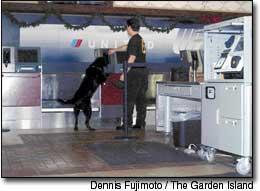LIHU‘E — Lyle Combs of the federal Transportation Security Administration (TSA) Canine Unit came bearing good news when he and handler Ken Gaymon arrived at Lihu‘e Airport with Gator, a TSA bomb dog. Combs informed TSA Kaua‘i director Shannon Garcia-Hamilton
LIHU‘E — Lyle Combs of the federal Transportation Security Administration (TSA) Canine Unit came bearing good news when he and handler Ken Gaymon arrived at Lihu‘e Airport with Gator, a TSA bomb dog.
Combs informed TSA Kaua‘i director Shannon Garcia-Hamilton that Maui and Guam are earmarked to each receive three dogs each, thus “putting Kaua‘i on the radar for dogs on the next list.”
Garcia-Hamilton pointed out the need to have a canine unit on Kaua‘i for those instances when transporting a dog from the O‘ahu station is not feasible. Primarily, Garcia-Hamilton is concerned about those times when the airport is closed down following the last passenger flight at night and the resumption of the first flights the following day.
Currently, TSA leaders maintain six teams, each team comprised of a bomb dog and its handler, who support the outer islands.
Gaymon, the handler for Gator, a black Labrador retriever, arrived to give TSA, Kaua‘i law-enforcement representatives, and officials from the Lihu‘e Airport and airlines servicing Lihu‘e a demonstration of the effectiveness of the canine unit.
The TSA Explosives Detection Canine Team is currently celebrating its 30th anniversary. Once managed under the Federal Aviation Administration (FAA) Civil Aviation Security section, the program now falls under the TSA’s Aviation Operation’s Law Enforcement Division.
Combs explained that because the explosives detection canine teams combine excellent mobility with reliable detection rates, the use of the teams today includes searching areas in response to bomb threats associated with luggage, cargo, vehicles, airport terminals and aircraft, as well as serving as general deterrents to any would-be criminals.
Gaymon said he and Gator were summoned to Kahului, Maui, following an incident where a truck was driven into the terminal. That team was searching for secondary devices that may have been present.
He also outlined his daily routine, which involves working with the mail before it gets moved to passenger airliners. Additionally, he and Gator work with the airlines when an overload situation occurs, the team’s effectiveness helping to move lines along.
Another area involves dealing with unattended bags when passengers inadvertently leave bags behind in terminals or on aircraft. The team is called in to screen the bags before they are removed.
More recently, Gaymon said the TSA teams were involved along with the Honolulu Police Department, the Secret Service, and the sheriff’s department during the Asia-Pacific Conference, where they were working with Homeland Security Secretary Tom Ridge.
The dogs are also used to search aircraft when a suspicious call is received. Gaymon explained that, by employing several teams, a narrow-bodied plane can be thoroughly searched in 10 to 15 minutes, while a wide-bodied aircraft takes upwards of 30 minutes to search.
On March 9, 1972, a TWA jet bound from New York to Los Angeles turned back to New York following a call of a bomb on board. Passengers were evacuated, and Brandy, a bomb-sniffing dog, located the device 12 minutes before it was scheduled to be detonated.
That same day, then-president Richard M. Nixon directed the Secretary of Transportation to use innovative ways to combat the problems plaguing civil aviation, the result being the birth of the explosive detection canine unit.
The program has expanded significantly, and Combs’ latest announcement is a result of 18 new airports being designated to receive canine teams.
Garcia-Hamilton, whose experience at the Los Angeles Airport has her familiar with the effectiveness of the canine units, explained that Lihu‘e Airport needs to form a partnership with private industry, and the community, in which Lihu‘e Airport officials voluntarily participate in, and are supported by federal funds.
The TSA officials pay to purchase and train the dogs, trains the canine handlers, and partially reimburses each participating agency for costs associated with maintaining the teams.
Garcia-Hamilton said she is currently talking with Kaua‘i Police Department Chief K.C. Lum.
Dogs utilized in the canine unit are trained by the TSA Support Branch located at Lackland Air Force Base using a conditioning model labeled “operant conditioning.”
This model is reward-based, where the dog is trained to indicate, or respond, to the location of an explosive odor. Once the dog responds correctly, he or she is given a reward that is of great value to the dog, such as a ball or other toy, or food.
During a demonstration, Combs hid a package containing a shirt bearing an explosive scent, and when ordered, Gator immediately honed in on the location in the airport conference room, and promptly parked himself while waiting for Gaymon to fish a reward tidbit out of his pocket.
Expanding the demonstration to the terminal lobby of the airport, Combs again hid the package, and following some quick stops for a more detailed search, Gator again honed in on the package that was placed inside one of the check stations.
Combs noted that once the location of the explosive is determined, law enforcement personnel take over.
The reward for Gator comes in different forms, too, as departing visitor Jessica McKenna of Hornby Island, Canada, asked Gaymon, “May I pet your dog?”
Dennis Fujimoto, staff writer and photographer, may be reached at 245-3681 (ext. 253) or dfujimoto@pulitzer.net.


